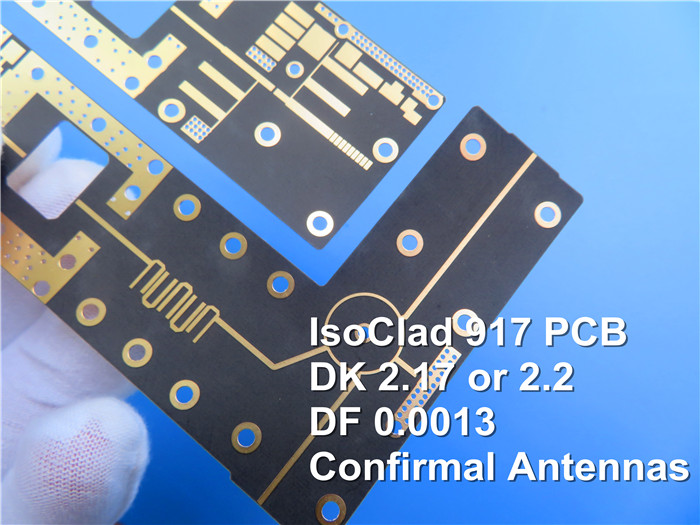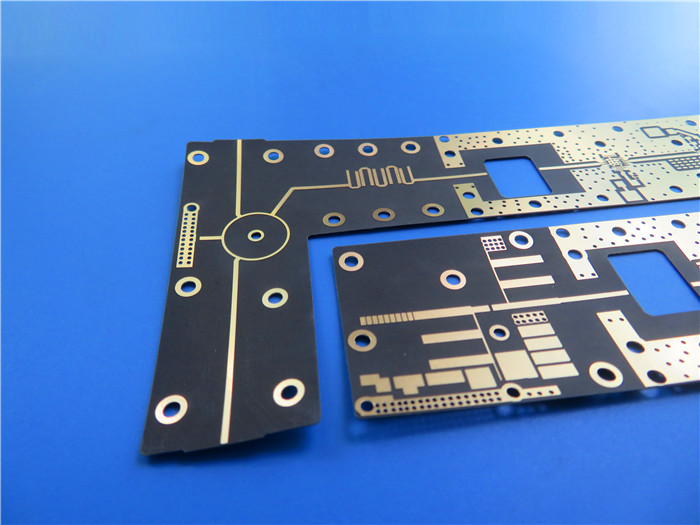Introduction
Today, we will delve into the groundbreaking technology of Rogers IsoClad 917 laminates, which are revolutionizing the realm of Rogers printed circuit board substrates. These laminates feature a unique composition of non-woven fiberglass and PTFE composites in a low ratio, resulting in the lowest dielectric constant and dissipation factor within their class.
The incorporation of non-woven fiberglass reinforcement enables the use of IsoClad 917 laminates in applications requiring flexibility and shaping, such as conformal or wrap-around antennas. Notably, the longer random fibers and proprietary manufacturing process contribute to enhanced dimensional stability and uniformity of dielectric constant, surpassing competing laminates in the market.
Let us now explore the typical properties of IsoClad 917 laminates.

IsoClad 917 Typical Properties
One of the notable features of IsoClad 917 is its dielectric constant, which ranges between 2.17 and 2.20 depending on the specific formulation.
Rogers IsoClad 917 Printed Circuit Board exhibits an exceptionally low dissipation factor of 0.0013 at 10 GHz, indicating minimal signal energy loss during transmission.
With a high volume resistivity of 1.5 x 10^10 MΩ-cm and surface resistivity of 1.0 x 10^9 MΩ, IsoClad 917 ensures excellent electrical insulation.
It boasts a long arc resistance of over 180 seconds and a high dielectric breakdown voltage exceeding 45 kV.
In terms of thermal properties, IsoClad 917 demonstrates a thermal coefficient of Er of -157 ppm/°C, implying a change in dielectric constant with temperature. However, achieving an even lower thermal coefficient could be desirable.
IsoClad 917 exhibits a low coefficient of thermal expansion, with values of 46 ppm/°C in the X-axis, 47 ppm/°C in the Y-axis, and 236 ppm/°C in the Z-axis.
The material's thermal conductivity at 100°C is relatively modest at 0.263 W/mK.
In terms of mechanical properties, IsoClad 917 displays good performance. It possesses a peel strength of 10 lbs. per inch after thermal testing, a tensile modulus of 133-120 kpsi, a tensile strength of 4.3-3.8 kpsi, a compressive modulus of 182 kpsi, and a flexural modulus of 213 kpsi.
With a density of 2.23 g/cm3 at 23°C, IsoClad 917 offers a relatively high weight-to-volume ratio, which can be advantageous in specific applications.
IsoClad 917 demonstrates a low water absorption rate of 0.04%, indicating minimal susceptibility to moisture in the environment.
Regarding outgassing properties, the material exhibits a minimal total mass loss of 0.02% and collected volatile condensable material of 0.00%, meeting stringent requirements in low-pressure conditions.
Rogers IsoClad 917 Printed Circuit Board complies with the UL94-V0 flammability standard.
|
Property
|
IsoClad 917
|
Condition
|
Test Method
|
|
Dielectric Constant @ 10 GHz
|
2.17, 2.20
|
C23/50
|
IPC TM-650 2.5.5.5
|
|
Dissipation Factor @ 10 GHz
|
0.0013
|
C23/50
|
IPC TM-650 2.5.5.5
|
|
Volume Resistivity (MΩ-cm)
|
1.5 x 1010
|
C96/35/90
|
IPC TM-650 2.5.17.1
|
|
Surface Resistivity (MΩ)
|
1.0 x 109
|
C96/35/90
|
IPC TM-650 2.5.17.1
|
|
Arc Resistance (seconds)
|
>180
|
D48/50
|
ASTM D-495
|
|
Dielectric Breakdown (kv)
|
>45
|
D48/50
|
ASTM D-149
|
|
Thermal Coefficient of Er (ppm/°C)
|
-157
|
-10°C to +140°C
|
IPC TM-650 2.5.5.5
Adapted
|
|
Coefficient of Thermal Expansion (ppm/°C)
|
|
0°C to 100°C
|
IPC TM-650 2.4.24 Mettler 3000 Thermomechanical Analyzer
|
|
X Axis
|
46
|
|
Y Axis
|
47
|
|
Z Axis
|
236
|
|
Thermal Conductivity (W/mK)
|
0.263
|
100°C
|
ASTM E-1225
|
|
Peel Strength (lbs.per inch)
|
10
|
After Thermal
|
IPC TM-650 2.4.8
|
|
Tensile Modulus (kpsi)
|
133, 120
|
A, 23°C
|
ASTM D-638
|
|
Tensile Strength (kpsi)
|
4.3, 3.8
|
A, 23°C
|
ASTM D-882
|
|
Compressive Modulus (kpsi)
|
182
|
A, 23°C
|
ASTM D-695
|
|
Flexural Modulus (kpsi)
|
213
|
A, 23°C
|
ASTM D-790
|
|
Density (g/cm3)
|
2.23
|
A, 23°C
|
ASTM D-792 Method A
|
|
Water Absorption (%)
|
0.04
|
E1/105 + D24/23
|
MIL-S-13949H 3.7.7
IPC TM-650 2.6.2.2
|
|
Outgassing
|
|
|
|
|
Total Mass Loss (%)
|
0.02
|
125°C, ≤10-6 torr
|
Maximum 1.00%
|
|
Collected Volatile Condensable Material (%)
|
0.00
|
|
Maximum 0.10%
|
|
Water Vapor Regain (%)
|
0.02
|
|
|
|
Visible Condensate (±)
|
NO
|
|
|
|
Flammability
|
Meets requirements of
UL94-V0
|
C48/23/50, E24/125
|
UL 94 Vertical Burn IPC TM-650 2.3.10
|
IsoClad 917 PCB Capability
We provide a range of PCB capabilities utilizing IsoClad 917 substrates:
Single-sided boards, double-sided boards, multi-layer boards, and hybrid designs are available.
Copper weights on tracks and pads include options for 1oz (35µm) and 2oz (70µm).
Dielectric thicknesses are offered at 20mil (0.508mm), 31mil (0.787mm), and 62mil (1.575mm).
The maximum board size is 400mm by 500mm, accommodating single large boards or multiple designs on a single sheet.
Various solder mask options in green, black, blue, yellow, and red are available to suit design requirements.
Surface finishes include immersion gold, HASL, immersion silver, immersion tin, ENEPIG, OSP, bare copper, and pure gold plating.
|
PCB Material:
|
Non-woven Fiberglass / PTFE Composites
|
|
Designation:
|
IsoClad 917
|
|
Dielectric constant:
|
2.17 or 2.20 (10 GHz)
|
|
Dissipation factor
|
0.0013 (10 GHz)
|
|
Layer count:
|
Single Sided, Double Sided, Multi-layer PCB, Hybrid PCB
|
|
Copper weight:
|
1oz (35µm), 2oz (70µm)
|
|
Dielectric thickness
|
20mil (0.508mm), 31mil (0.787mm), 62mil (1.575mm)
|
|
PCB size:
|
≤400mm X 500mm
|
|
Solder mask:
|
Green, Black, Blue, Yellow, Red etc.
|
|
Surface finish:
|
Immersion gold, HASL, Immersion silver, Immersion tin, ENEPIG, OSP, Bare copper, Pure gold plated etc..
|
A Sample of IsoClad 917 PCB
Displayedfollowing is a hybrid design Rogers IsoClad 917 PCB, showcasing the versatility of this material. It finds typical applications in conformal antennas, stripline and microstrip circuits, guidance systems, and radar systems, among others.

Conclusion
IsoClad 917 Rogers material can be seamlessly integrated into different manufacturing tooling systems. The choice of pin types, tooling formats, and punching methods will depend on the manufacturing facility's capabilities and registration requirements. Maintaining copper around tooling holes is recommended to improve layer registration, regardless of the chosen approach.
When applying adhesives between circuits and around the panel perimeter, a flow pattern compatible with the selected adhesive system can be employed. Maximizing the retention of copper improves layer registration in general.

 Call Us Now !
Tel : +86 755 27374946
Call Us Now !
Tel : +86 755 27374946
 Order Online Now !
Email : info@bichengpcb.com
Order Online Now !
Email : info@bichengpcb.com















